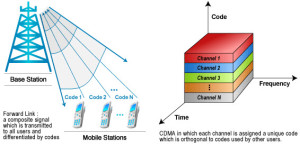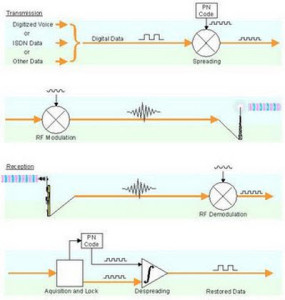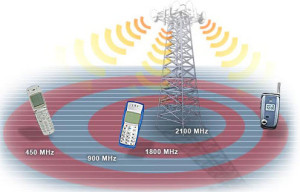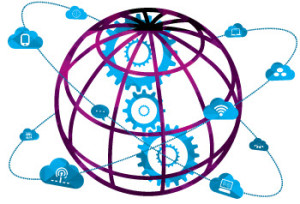CDMA technology was originally designed
by Qualcomm in the U.S., and it is primarily used in U.S. and other
places in Asia by other carriers. Nowadays 14% of the worldwide market
is choosing CDMA because it leaves more space at the time of data
transferring. CDMA is radically a new concept in wireless communications
wherein both data and voice are separated from the signals using codes,
and then it is transmitted by using a wide range of frequency.
GSM and CDMA are two dominant
technologies in mobile communication. These technologies differ in the
way both calls and data travel over a mobile network. When we compare
both technologies, the GSM technology
has some limitations as far as the quality is concerned; still, it is
more flexible compared to the CDMA technology. The difference between
GSM and CDMA can be considered in terms of technology they use, the
security factors, and the data transfer speeds, and so on.
What is CDMA Technology?
CDMA technology is used in commercial
cellular communications to make better use of radio spectrum when
compare to other technologies. This technology was used as a military
technology for first time in the World War II by the English associates
to break the German attempts of jamming transmissions.
CDMA technology is known as a
spread-spectrum technique which allows many users to occupy the same
time and frequency allocations in a given band and space. Individual
conversations are encoded with the help of pseudo-random digital
sequence.
- Synchronous CDMA
- Asynchronous CDMA
Synchronous CDMA
Synchronous CDMA is defined as
exploiting the mathematical properties orthogonally between vectors
representing the data strings. This digital modulation method is
analogous to the one used in simple radio transceivers.
For example, let us consider a binary
string “1011” which is represented by the vector (1, 0, 1, 1). These
vectors can be multiplied by taking their dot product and sum of
products with respect to the components. If dot product is zero, then
the two vectors are said to be in orthogonal.
Asynchronous CDMA
If mobile-to-base links are not exactly
matched, particularly due to handsets mobility, a different approach is
required. This type of CDMA is not mathematically possible to create
signature sequences which are orthogonal for arbitrarily random starting
points, and thus make use of the code space. Pseudo-random or
pseudo-noise sequences are used in asynchronous CDMA systems.
This CDMA system offers a key advantage
in the flexible allocation of resources. Asynchronous CDMA is best
suited to a mobile network wherein large numbers of transmitters produce
relatively small amount of traffic at irregular intervals.
CDMA is a form of direct sequence spread
spectrum communications. This spread spectrum communication can be
illustrated by using these key elements:
Multiple accesses: The
use of spreading codes which is independent for each user along with
synchronous reception will allow multiple users to access the same
channel simultaneously.
Use of Wide Bandwidth:
CDMA like other spread-spectrum technologies uses a wider bandwidth than
would otherwise be needed for the transmission of data. This results in
a number of advantages including an increased immunity to interference
and multiple user access.
Level of Security: In
order to receive the data, the receiver synchronizes the code to recover
the data. The use of an independent data and synchronous reception
allows multiple users to access the same frequency band at same time.
Working of CDMA
Code Division Multiple Access is
entirely a different approach from the Time Division Multiple Access.
CDMA, after digitizing the data, spreads out the date over the entire
available bandwidth. Multiple calls are overlapped to each other on a
channel which is assigned with a unique sequence code. CDMA is a form of
spread-spectrum technique, which means data can be sent in small pieces
over a number of frequencies available to use at any time in the
specified range.
All the users’ data can be transmitted
in a similar way to that of wide band chunk of spectrum. Users Signals
are spread over the entire bandwidth by a unique spreading code. At the
receiver end, the same code is used to recover the signal. CDMA system
requires accurate time stamp on each piece of a signal. Eight and ten
separate calls are carried out in the same channel space as one analog
call.
Types of Spread Spectrum Communications: There are three types of spread spectrum communications:
- Frequency Hopping
- Direct Sequence
Frequency Hopping
Frequency hopping is the easiest of all
the spread spectrum modulation technique to use. The idea behind
frequency hopping is to transmit data across a broad spectrum; the
frequency can be rapidly switched from one to another. The transmitter and receiver
are synchronized every time, and an accurate clocking system, and
pseudo generating system make this frequency hopping very simple.
Direct Sequence
Direct sequence is the most famous
spread spectrum technique in which the data signal is multiplied by a
Pseudo-random noise code. A PN code is a sequence of chips which is
given values as -1 and 1 (non polar) or 0 and 1 (polar). The number of
chips within one code is known as the period of this code. The digital
data is directly coded at higher frequency, and the code is generated
pseudo randomly. A receiver knows how to generate the same code and
correlates the received signal with that code to extract the data.
The above figure shows that one channel
is operated in one direction and the signal transmission consists of the
following steps:
- A pseudo-random code is generated which is different for each channel and each successive connection.
- The information data modulates the pseudo-random code, and a carrier signal gets modulated.
The modulated carrier signal is amplified and broadcasted, and the signal reception also involves the following steps:
- The carrier signal is received and amplified.
- The received signal is mixed with a local carrier to recover the spread digital signal.
- A pseudo-random code is generated and matched with the anticipated signal.
- The receiver acquires the received code and phase locks its own code to it.
- The received signal is correlated with the generated code, and the information data is extracted.
Advantages of CDMA Technology
The use of CDMA offers several
advantages that’s why CDMA technology is adopted by many of the 3G
cellular telecommunications systems. CDMA technology in mobile
communication possesses so many advantages. The following advantages are
a few of them:
Improvement in capacity and security:
One of the chief claims of CDMA is that it gives significant
improvements in network capacity. In CDMA technology data and voice
packets are separated using codes, and then transmitted by using a wide
range of frequencies. Because more space is allocated for data in CDMA,
this standard has become attractive for 3G high-speed mobile internet
use.
Improvement in hand over/ hand off:
By using CDMA technology, it is easy for a terminal to communicate with
two base stations at once. In case of this, old link is to be broken
when the new one is firmly established. This provides improvement in
terms of the reliability of hand over/hand off from one base station to
another.
CDMA technology has been used in 3G telecommunication systems
in one form or the other. CDMA has become successful in every aspect,
and it has enabled improvements need to be gained over the previous
technologies used in 2G systems.
Applications of CDMA technology
- Due to inherent advantages of CDMA over TDMA and FDMA such as user capacity, soft hand offs and security, etc., CDMA emerges as a winner in the battle of wireless technology and services. CDMA allows far greater development and the use of broad band devices such as wireless laptop modems, GPS system units and other innovative devices.
- For business purpose, CDMA supports in providing high speed push to talk and push to email services. Push to talk gives mobile an ability to be used as a walky-talky device. These services are exempted from the service charges imposed by the operators making CDMA cost effective.
- CDMA is considered as the highest mode of wireless communications, and is responsible for gibing fast and safe mode of data exchange such as 3G. Recently, CDMA has merged with the GSM technology to give a high-speed 4G or LTE internet services.
This article is all about the CDMA
technology and its applications. Furthermore, for any help or doubts
regarding this article, you can contact us by commenting in the comment
section given below.












No comments:
Post a Comment